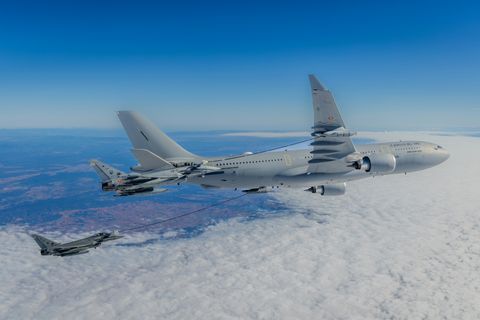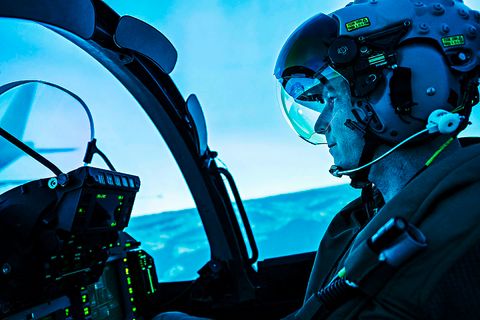The A400M: A force for global security and humanitarian aid

After a decade in service, the A400M has proven to be an indispensable tool for strengthening global security and protecting citizens in crisis situations. To ensure that pilots like Captain María Jesús Pérez de Zafra, who has flown the aircraft for the Spanish and French air forces, can respond reliably to any contingency, Airbus engineers like Sara Vargas continue to develop the A400M's versatility, including its future role as a fire-fighting aircraft.
One hundred and twenty four A400Ms have been delivered. The aircraft are in active service with eight air forces and are approaching 200,000 flight hours. In the past year alone, the A400M fleet worldwide has performed missions ranging from replenishment deliveries to Ukraine and international counter-terrorism operations to maritime rescue, conflict evacuation and natural disaster relief.
The French Air and Space Force was the first to operate the aircraft in 2013. Spanish national María Jesús Pérez de Zafra is now flying it as part of an exchange programme with the Spanish Air and Space Force. "It's a demanding experience that requires a constant effort to adapt. Each country prioritises certain requirements in pilot training and the use of the aircraft is different. What doesn't change is the A400M’s incredible versatility. We have flown at low altitude [150 feet] in the desert, carried out desert landings on unprepared runways, and run cargo and personnel air-drops in training with other A400Ms and a C130-J...".
A400M: indispensable in a crisis
The A400M has been used extensively in recent operations in both Africa and the Middle East. In this region, several European air forces have deployed the A400M as part of an international coalition focused on the fight against Daesh terrorism. These missions are mostly scheduled personnel transport and logistical support, but the crews must be ready for any unexpected event.
This was the case in April 2023, when the deteriorating security situation in Sudan worsened further due to the conflict between the Sudanese army and its paramilitary rival. Airbus’ four founding nations - France, Germany, Spain and the United Kingdom - relied on the A400M to evacuate their nationals, United Nations personnel and other citizens from Sudan (link).
Wherever there is conflict, disaster or vulnerable people in need of assistance, we are the first to deliver cargo and aid
said María Jesús Pérez de Zafra.
Captain Pérez de Zafra did not participate, but she did take part in the closure of the French air base in Niamey, the capital of Niger, following the coup d'état and the seizure of power by a military junta in July 2023. "From September to December, we operated rotations directly from our base in Orléans-Bricy to Niamey, practically twice daily, to redeploy as much material as possible over several months: helicopters, containers, vehicles,” she says.

María Perez de Zafra flew one of the A400Ms that, along with A330 MRTT Phénix and other aircraft, took part in the Pégase 2022 mission, an annual demonstration of the French Air Force's air power projection in the Indo-Pacific.
"Some missions can be emotional”, says Pérez de Zafra. She mentions, among others, the repatriation of bodies and survivors of the wreck of a Spanish trawler in Newfoundland (Canada), in February 2022; or the evacuation of refugees from Kabul (Afghanistan), in August 2021.
The best reward for a military man is to see how his work helps other people's lives

María Jesús Pérez de Zafra obtained her A400M pilot licence in 2018: "The army makes you feel that you have the same skills as everyone else. In addition, the presence of women is growing. My line manager and squadron instructor is a woman, and there are three female pilots in the French squadron I fly in. I have flown several missions where the two pilots in the cockpit were women."
Up to 25 A400Ms from six different customers and nine A330 MRTTs from six different operators were used to evacuate thousands of refugees from Kabul in 2021. "You hold in your hands the lives of many people who are leaving everything behind: their country, their lives, much of their family. It was heartbreaking to see whole families, almost half of them children, arriving with virtually no luggage, their lives stuffed into a suitcase".
In 2023, A400Ms from Turkey, Germany, Spain, Belgium and Malaysia formed the backbone of the humanitarian air corridor set up after the devastating earthquakes that shook eastern Turkey and Syria in February 2023. Hundreds of flights carried humanitarian supplies and rescue personnel. Then British and Spanish A400Ms joined support operations following the earthquake in Morocco in September 2023, as did German and French A400Ms following the floods in Libya in October that year. More recently, French A400Ms have also been flying to an Egyptian airport near the Gaza border to transport humanitarian aid.
Ten years young: The A400M levels up
The A400M’s versatility has only increased in recent years, with the certification of highly complex capabilities such as in-flight refuelling of helicopters, low-level flight, or the refuelling of the A400M as a receiver. "Some of these capabilities are unique for a transport aircraft," says Sara Vargas, A400M development programme manager at Airbus Defence and Space.
Vargas likes to say that she has "suffered every bolt" of the A400M. In 15 years, she has held various positions in the flight test team, including the preparation of all development prototypes. For example, certifying the simultaneous dispatch of up to 116 parachutists required hundreds of flight tests with real jumps, data collection and thousands of engineering hours analysing flight trajectories.
"A400Ms often fly into conflict zones and onto unprepared runways. When I see how the aircraft has developed and how the customer nations are actively using it, I can't help but feel proud." Sara Vargas.

Sara Vargas joined the A400M flight test instrumentation team at the San Pablo site in Seville in 2008 and has been part of many test flight campaigns.
New roles for the future: FCAS integration and firefighting
The A400M development process is about to enter a new era, introducing designs and technologies that go beyond the launch contract to support campaigns for potential new customers. Vargas is leading the development of new roles for the aircraft, such as its integration into the System of Systems that will make up the Future Combat Air System (FCAS). She explains: "We have already launched a drone from an A400M in flight for the first time [link], demonstrating the viability of this essential function for FCAS. In upcoming trials, we will test the remote control of an unmanned platform launched from the A400M".

Another future development is to convert the A400M into a firefighting aircraft by integrating a detachable firefighting kit - without needing to modify the aircraft. "In just one year we have achieved very promising results [link]. In the future, this capability will help to combat the tragedy of forest fires, which are increasing every year".
It’s capability that, when it comes to fruition, will once again justify Pérez de Zafra's words about the purpose of the crews flying the A400M. "We are always there in the bad times, because in the good times we are usually not needed. As the motto of my former unit, the 31st Wing, says: 'Whatever, wherever, whenever'".
Read more on A400M



